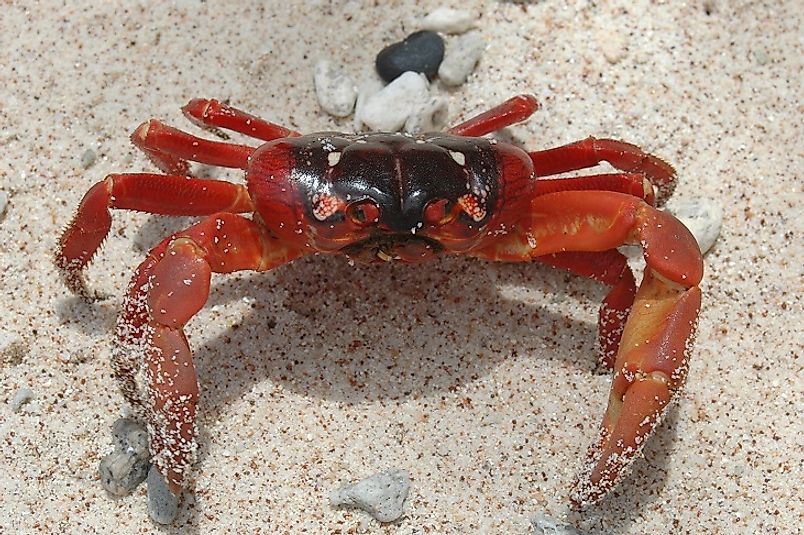Christmas Island Red Crabs - Animals Of Oceania

5. Physical Description
At the beginning of the wet season every year, a grand spectacle awaits those who visit the Christmas Island on the Indian Ocean. Swarms of bright red crabs can be observed crawling their way from the forests in the island to the coast for breeding and spawning purposes. These crabs known as the Christmas Island crabs (Gecarcoidea natalis), are large land-dwelling crabs which can grow up to sizes of about 116 millimeters. The crabs are usually red in color, though orange and purple varieties might also exist. The crabs exhibit sexual dimorphism where males are larger in size than the females while the latter possesses a broader abdomen and smaller claws than the former.
4. Diet
The Christmas Island crabs have a wide and varied diet choice and face very little competition from other occupants of their habitat due to their sheer high numbers and dominance over the forest floor of the island. The crabs usually feed on plant parts that graze the ground as well as dead and decomposing bodies of animals like other crabs, snails, and even human generated waste products.
3. Habitat, Range, and Migration
The red crabs are endemic to Christmas Island and Cocos (Keels) Island on the Indian Ocean and population of these crabs in the former place is estimated to be 43.7 million with between 0.09 and 0.57 crabs per square meter of land. The crabs usually dig burrows in the soil or rock crevices in the moist tropical forests of the island where they live most of the year. These crabs prefer a solitary habit and a single burrow is occupied by a single crab. At the beginning of the wet season, these crabs leave their burrow and emerge from the forests from where they start migrating to the coast. The males usually arrive first followed by the females. The males dig burrows for themselves on the beach and guard the burrows against other males. After the pairs mate, the males migrate back to the forest while the female stays in the burrow for a couple of weeks till she is ready to lay her clutch of eggs. The female lays her eggs in the sea and returns back to the forest. The migration of these crabs also strictly adheres to the lunar cycle in a manner that eggs are released into the sea during the last quarter of the moon. This migration of the crabs, as they move down cliffs, over and across obstacles in their way, offers an arresting sight to those who visit the island to watch this sight. Peak time for migration movements of these crabs is usually just after sunrise and just before sunset when temperatures are cool enough to keep the crabs hydrated.
2. Behavior
Red crabs are terrestrial crabs that prefer a solitary habit where a single burrow is occupied by a single crab. The crabs use their gills for breathing and thus tend to get dehydrated easily. The are completely diurnal in their activities and never come out in the night. They tend to avoid the direct heat of the sun and usually take cover in the shade or move through shaded places. For nearly 3 months during the dry season the crabs appear to disappear to conserve the water in their body. They also guard the mouths of their burrows with leaves during this time.
1. Reproduction and Life Cycle
After the female red crab lays her eggs in the sea, the eggs start hatching and the hatchlings that emerge in the form of crab larvae are soon swept into the sea where the larvae go through a series of larval developmental stages for about 3 to 4 weeks till it forms tiny shrimp like creatures called megalopae. The megalopae then swim towards the shore where they undergo further transformation to form small, young crabs. These crabs then migrate into the forests of the island where they remain hidden in the forest floor debris, rock outcrops or other hiding stations for nearly 3 years, attaining sexual maturity at about the age of 4 to 5 years when they start exhibiting the adult migration phenomenon for breeding and reproduction.











